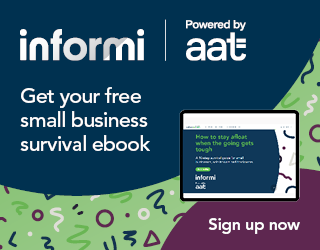Sponsored post by Daniel Plant
Business across all sectors can be a challenge, even when things are going well and the economy is booming. The unexpected loss of a major customer or a protracted payment dispute can put pressure on cashflow which, if not carefully managed, can soon turn a drama into a crisis.
Many businesses fail, not because they don’t have a great product or service, or even a full order book, but more often because they’ve spent too much time ‘doing the day job’ and not enough time focusing on the cash.
Such challenges are difficult enough when times are good. Throw in a global pandemic, and that challenge is taken to another level. The Government responded quickly and decisively to help small businesses with a variety of employer and employee support programmes and funding packages, and in tax breaks and payment holidays, many of which have been extended.
But even with the generous support of the Chancellor, such support cannot go on indefinitely. The furlough scheme will end eventually, repayments of loans will fall due, and deferred payments cannot be put off forever. All of which will create ‘pinch points’ on a company’s cash and impact its ability to recover.
If you are sitting there wondering whether or not your business can survive through these challenging times, then it’s time to stand up, take stock and start thinking strategically with a well thought out game plan.
You don’t just want to survive; you want to grow. Knowing where to begin, however, can appear somewhat daunting, but it doesn’t have to be. Actually, once you break it down into bite-size steps the answers tend to present themselves.
To some, the default position is to borrow more cash. That may, indeed, be the answer, and there are a host of providers out there willing to lend a hand, but it may not be the right answer at this time.
Taking on more debt, and having to service it, may not be the smart decision and may simply serve to accelerate the difficulties you face.
Surviving and growing without having to resort to borrowing may be a more considered plan, and in doing so, specifically looking at certain key areas: financial forecasts; HMRC arrears; handling your creditors and suppliers; communicating with your customers; reviewing your overheads; and understanding Government assistance.
So let’s deal with each point in turn.
Financial forecasting
Forecasts are not just helpful, or a ‘nice to have’; they are essential. Indeed, your future may depend on the accuracy of your forecasts. Regardless of the size of your business, you can never underestimate the value of projections. The ones you can adjust in real time, as you go through each week, can give you greatest insight into your future business requirements.
Forecasting represents the foundation for everything else that follows. A Profit and Loss forecast, for example, is unquestionably helpful in understanding where you are going and will determine how viable your company remains. Heading towards a loss or continuing with ongoing losses should quite rightly cause concern and serve as a timely alert to prompt you to seek professional advice to protect yourself personally as well as the other stakeholders.
The ongoing profitability or otherwise of your business may, however, be uncertain and although forecasts against actuals are extremely helpful, cash on the other hand (especially in the short term) is absolute king.
What a forecast will give you is total transparency on all key survival indicators and alerts. It will highlight Where the pinch points are, and whether or not you can survive without borrowing. It will help to demonstrate whether or not your company (as is) remains viable and indicate your best estimate on future requirements.
The best cashflow forecasts are the ones you can adjust weekly to ensure your modelling moves with real time data. Data that is too historic can give you a misleading picture of your true position, so timeliness and relevance are everything.
Ideally, you can navigate your way through without having to borrow or seek any formal insolvency protection from your creditors. Such routes, however, are not always unavoidable, but either way an interactive cashflow forecast is key to discovering where those liquidity issues may be hiding, so there are no unpleasant surprises.
You may already know, for example, that you have an HMRC payment due or that the next quarter’s rent is fast approaching. Having this information in your head, however, is not the same as having an adjustable cashflow forecast which can help you see the big picture and make you think more strategically.
Fully armed with your best estimates of what is coming down the road, can give you precious time in the immediate term to address a future problem.
So, you’ve done your forecasting and the short-term or long-term projections show you running out of cash. What next? Before you start looking to borrow more money, and saddle your business with potentially unmanageable debt, begin by exploring ways of addressing your cashflow squeeze.
HMRC Arrears
If you have HMRC arrears or have already taken advantage of the Government’s deferred VAT scheme, then you’ll be in good company with a significant proportion of other UK businesses. More often than not, it’s HMRC debt that presents the biggest issues on cash flow.
As well as the deferment VAT scheme covering the quarter March 2020 to June 2020, HMRC is also allowing Company’s Time to Pay that deferred element over 12 months starting from March 2021. You will need to opt in here.
If you still can’t pay your tax bill on time, HMRC recommends you contact them as soon as possible: https://www.gov.uk/difficulties-paying-hmrc/. You can also appoint an advisor/intermediary to act on your behalf and support you in creating a Time To Pay Proposal to HMRC in the required format on a no win/no fee basis.
Handling your creditors
As most businesses are all in the same position, you would expect your creditors to be somewhat sympathetic to your current difficulties. Whereas there will always be a few exceptions, most creditors will be wanting to work with you in finding a solution.
Such generosity of spirit, however, should not be taken for granted, and the golden rule is never to bury your head in the sand. Ignoring the calls, emails and letters chasing you for payment will not make the problem go away. It could, in fact, make matters worse.
Instead, review your latest cashflow forecasts and determine what exactly is affordable. Armed with this intelligence, you are then in a position to negotiate weekly/monthly payment terms with creditors, while also keeping them informed if the position changes (for better or worse). Transparency, openness and honesty are still useful commodities. Engagement is key.
As for suppliers, find out if they are prepared to extend credit terms to give you more time to settle any outstanding debts and easing up further pressure on your cashflow. Often you are part of an established supply chain and it is in everyone’s interest for that chain not to be broken.
Communicating with customers
Just as important as managing your creditors, is speaking to your major customers and debtors. For customers, find out how their business has been affected and seek transparency on their future needs for your service/product: will they increase or decrease, or are they expected to stay at the same level?
Don’t expect business volumes or values to stay the same necessarily. Indeed, don’t ‘assume’ anything; make informed decisions based on a clear picture of the market you are operating in.
As for your outstanding debtors, find out if payment will be made within business terms. If they are going to struggle, then negotiate a settlement that satisfies both parties wherever possible. Getting an understanding on your cash ‘inflow’ is without question just as important (if not more so) than your ‘outflows’. Therefore, update your forecasts as further information becomes available and follow up with written confirmation of payment terms.
Overhead review
If you are not already doing so, businesses should undertake a review of overheads (staff costs, rent, insurances, etc.) every year at the very least, and more frequently in difficult times. Now, more than ever, is the time to look at any unnecessary costs to your business and work out what can be cut or what could be simply reduced.
With so many people working from home, do you need the same office space in future, for example? Can salaries be trimmed or hours reduced to reflect different ways of working and negligible costs of commuting with staff no longer in an office full time?
This is always a difficult decision, especially for business owners with loyal staff. There is also always a difficult balance between reducing staff numbers, and still being able to provide a viable service. This is again where having total visibility of the numbers is important. As a tip, look at last year’s costs and compare them to this year as a benchmark to help find what can be done differently to reduce overheads
Government assistance
In addition to a number of other initiatives to support the economy introduced in 2020, the Government also launched a new £20m fund to boost the recovery of small businesses. Beyond paying for new equipment and technology, one of the main purposes of the fund, which has been launched in response to the pandemic, is for it to be used to pay for specialist advice.
If you qualify, then take advantage of this windfall and seek professional help to sanity-check your game plan, review (or even put together) your forecasts, and guide you through these uncertain times.
Conclusion
It is said that a business owner with a plan will nearly always beat a genius without one. To that end, a carefully thought-out strategy is the key to putting yourself back in the driving seat. Start with a cashflow forecast and work out where those pinch points are, then move on to talking to certain stakeholders with that financial intel (the above are a number of the key ones) to help tailor your approach.
This approach might not give you all the answers, it might not even save your company, but without question it’s a great start in taking control back and plotting a path forward.
Daniel Plant is the founder and owner of the turnaround specialists, the SFP Group. More on them here



